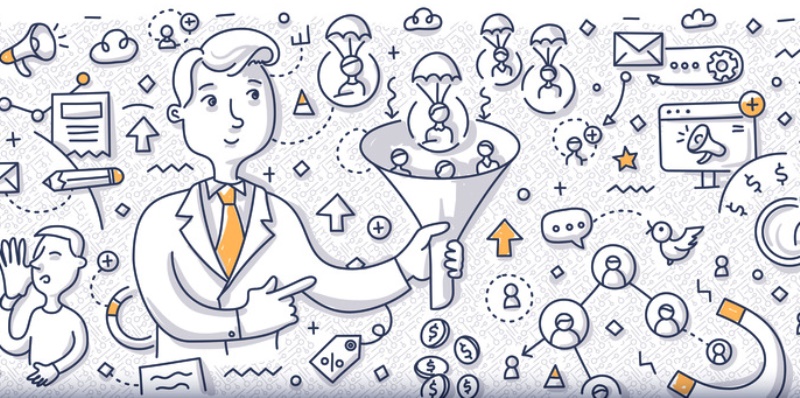The noise at the top of the funnel is just too great to accomplish much with an unproven funnel. You define a persona, acquire a list or use PPC, create an autoresponder, and go through that hierarchy-type thinking to find the decision-maker if it is a substance purchase. It requires Harry Potter-like magic thinking and assumes that you know everything initially. For instance, creating a marketing funnel from scratch assumes you can calculate based on what we know and that of the prospect and another set of factors that are completely unpredictable, including competition, environment, buying patterns, misunderstandings, and errors of perception.
Marketing is not a deterministic process. While anyone can develop marketing strategies or ideas, creating them without considering customers can limit the chances of success. Marketing approaches and tools are not the focus. Instead, it’s the conversations you foster. Moreover, marketing isn’t solely about maximizing effort at the sales funnel’s top. The initial step is to take a step backward. This lacking piece, often overlooked by eager marketers, is called market orientation: your unique space in the industry. Market Orientation. Here, we construct numerous micro-markets and organize them into an ‘opportunity map’ encompassing viable prospects. Planning is crucial, but the best-laid plans often change during the first customer interaction.
The Challenges of Building a Marketing Funnel from Scratch
Building a Marketing Funnel from Scratch can be challenging for many businesses. Here are some of the main difficulties they may encounter:
- Understanding the customer journey: One of the first hurdles is clearly understanding the customer journey. This involves identifying each stage, from awareness to conversion, and mapping out how customers interact with your brand throughout their buying process.
- Creating engaging content: Creating compelling and relevant content for each funnel stage is another challenge. It’s important to cater to different audience segments and address their specific needs or pain points at every step.
- Monitoring and optimizing performance: Finally, tracking and optimizing the performance of your marketing funnel can be complex. You must set up metrics, analyze data, and make data-driven decisions that improve efficiency and drive results.
The Limitations of Initial Knowledge in the Funnel Process
- Limited initial knowledge can hinder the success of a marketing funnel.
- An important limitation is that customers may not be aware of your product or service at the top of the funnel and, therefore, won’t consider it an option.
- Another limitation stems from customers’ limited understanding of their needs and wants. This lack of awareness makes it challenging for marketers to communicate how their offering addresses those needs effectively.
- Attempting to engage with all potential leads could also lead to ineffective targeting. By casting too wide a net, valuable resources may be wasted on uninterested prospects who do not fit your target audience.
The abovementioned limitations highlight the need for careful research and planning when developing marketing funnels. It’s crucial to identify who your ideal customer is, understand their pain points, and tailor messaging accordingly throughout each stage of the funnel.
The Unpredictable Factors Impacting Funnel Success
External Factors
- Economic conditions play a significant role in funnel success. When the economy thrives, consumers are more likely to have disposable income and be open to purchasing products or services.
- Market competition can impact funnel success as well. If there are many similar offerings available, it becomes crucial for marketers to differentiate their products and build a strong value proposition.
- Changing consumer trends also influence funnel success. For example, if there is a shift towards eco-friendly products, marketers must adapt their strategies accordingly.
Internal Factors
- Effective targeting is essential for successful funnels. Marketers must accurately identify their target audience and tailor their messaging to them.
- The quality of leads generated impacts conversion rates throughout the funnel. Having qualified leads increases the likelihood of conversions at each stage.
- Consistent messaging across all funnel stages reinforces brand identity and builds trust with potential customers.
Understanding these factors allows marketers to adjust their strategies and optimize marketing funnels for better results.
Overcoming the Noise at the Top of the Funnel
Understanding the Challenge: At the top of the marketing funnel, businesses face a significant challenge of breaking through the noise and grabbing their audience’s attention. With so many competing messages and distractions, standing out from the crowd and making a lasting impression can be difficult.
Clear Targeting and Messaging: To overcome this challenge, it is crucial to understand your target audience and tailor your messaging accordingly clearly. By defining your ideal customer profile, you can create content that speaks directly to their needs, interests, and pain points. This targeted approach increases the chances of capturing their attention amidst the noise.
-
-
- Conduct thorough market research to identify key demographic information about your target audience.
- Craft a compelling value proposition that communicates how your product or service solves their problems or fulfills their desires.
- Use concise language and simple words in your messaging to ensure clarity.
-
Leveraging Multiple Channels: It is important to leverage multiple marketing channels to reach more potential customers at the top of the funnel. You can increase brand visibility across different touchpoints by utilizing various platforms such as social media, email marketing campaigns, search engine optimization (SEO), content marketing, and paid advertising.
Conclusion: By employing these strategies for overcoming noise at the top of the funnel—understanding your audience and crafting tailored messages while leveraging multiple channels—you can enhance brand recognition amid competition while increasing conversions throughout each stage of your marketing funnels.

